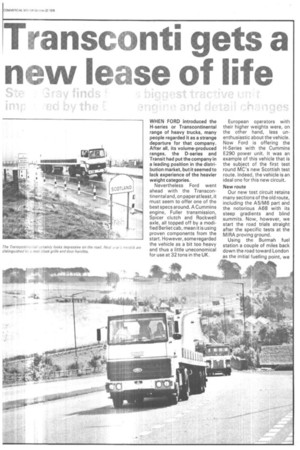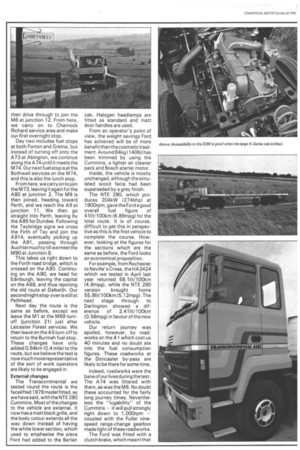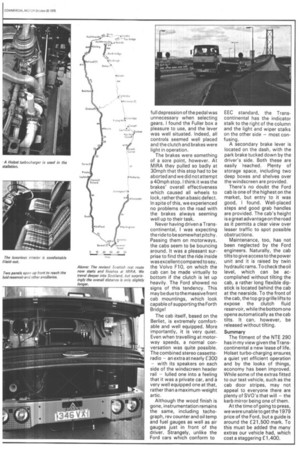Transconti gets a new ease of life
Page 131

Page 132

Page 133

If you've noticed an error in this article please click here to report it so we can fix it.
WHEN FORD introduced the H-series or Transcontinental range of heavy trucks, many people regarded it as a strange departure for that company. After all, its volume-produced ranges, the D-series and Transit had put the company in a leading position in the distribution market, but it seemed to lack experience of the heavier weight categories.
Nevertheless Ford went ahead with the Transcontinenta I and, on paper at least, it must seem to offer one of the best specs around. A Cummins engine, Fuller transmission, Spicer clutch and Rockwell axle, all topped off by a modified Berliet cab, mean it is using proven components from the start. However, some regarded the vehicle as a bit too heavy and thus a little uneconomical for use at 32 tons in the UK. European operators with their higher weights were, on the other hand, less unenthusiastic about the vehicle. Now Ford is offering the H-Series with the Cummins E290 power unit. It was an example of this vehicle that is the subject of the first test round MC's new Scottish test route. Indeed, the vehicle is an ideal one for this new circuit.
New route Our new test circuit retains many sections of the old route, including the A5/M6 part and the notorious A68 with its steep gradients and blind summits. Now, however, we start the road trials straight after the specific tests at the MIRA proving ground.
Using the Burmah fuel station a couple of miles back down the road toward London as the initial fuelling point, we then drive through to join the M6 at junction 12. From here, we carry on to Charnock Richard service area and make our first overnight stop.
Day two includes fuel stops at both Forton and Gretna, but instead of turning off onto the A73 at Abington, we continue along the A74 until it meets the M74. Our nextfuel stop is atthe Bothwell services on the M74, and this is also the lunch stop.
From here, we carry on to join the M73, leaving itagain for the A80 at junction 2. The M9 is then joined, heading toward Perth, and we reach the A9 at junction 11. We then go straight into Perth, leaving by the A85 for Dundee. Following the Taybridge signs we cross the Firth of Tay and join the A914, eventually picking up the A91, passing through Auchtermuchtytill we meet the M90 at Junction 8.
This takes us right down to the Forth road bridge, which is crossed on the A90. Continuing on the A90, we head for Edinburgh, leaving the capital on the A68, and thus rejoining the old route at Dalkeith. Our second night stop-over is still at Pathhead.
Next day the route is the same as before, except we leave the M1 at the M69 turnoff (junction 21) just after Leicester Forest services. We then leave on the A5 turn-off to return to the Burmah fuel stop. These changes have only added 0.64km (0.4 mile) to the route, but we believe the test is now much more representative of the sort of work operators are likely to be engaged in.
External changes The Transcontinental we tested round the route is the facelifted 1979 model fitted, as we have said, with the NTE 290 Cummins. Most of the changes to the vehicle are external. It now has a matt black grille, and the body colour extends all the way down instead of having the white lower section, which used to emphasise the piece Ford had added to the Berliet cab. Halogen headlamps are fitted as standard and matt door handles are used.
From an operator's point of view, the weight savings Ford has achieved will be of more benefit than the cosmetic treatment. Around 64kg (1401b) has been trimmed by using the Cummins, a lighter air cleaner pack and Bosch starter motor.
Inside, the vehicle is mostly unchanged, although the simulated wood facia had been superseded by a grey finish.
The NTE 290, which produces 204kW (274bhp) at 1900rpm, gave the Ford a good overall fuel figure of 411it/100km (6.89mpg) for the total route. It is of course, difficult to get this in perspective as this is the first vehicle to complete the course. However, looking at the figures for the sections which are the same as before, the Ford looks an economical proposition.
For example, from Rochester to Neville's Cross, the HA3424 which we tested in April last year returned 58.11it/100km (4.8mpg), while the NTE 290 version brought home 55. 8lit/100km (5.12mpg). The next stage through to Darlington showed a diference of 2.411it/100km (0.56mpg) in favour of the new vehicle.
Our return journey was spoiled, however, by roadworks on the Al which cost us 40 minutes and no doubt ate into the fuel consumption figures. These roadworks at the Doncaster by-pass are likely to be there for sometime.
Indeed, roadworks were the bane of our livesduring thetest. The A74 was littered with them, as was the M6. No doubt these accounted for the fairly long journey times. Nevertheless the "lugability" of the Cummins — it will pull strongly right down to 1,000rpm — coupled with the Fuller ninespeed range-change gearbox made light of these roadworks.
The Ford was fitted with a clutch brake, which meantthat full depression of the pedal was unnecessary when selecting gears. I found the Fuller box a pleasure to use, and the lever was well situated. Indeed, all controls seemed well placed and the clutch and brakes were light in operation.
The brakes were something of a sore point, however. At MIRA they pulled so badly at 30mph that this stop had to be aborted and we did not attempt a 40mph stop. I think it was the brakes' overall effectiveness which caused all wheels to lock, rather than a basic defect. In spite of this, we experienced no problems on the road with the brakes always seeming well up to their task.
Never having driven a Transcontinental, I was expecting the ride to be somewhat pitchy. Passing them on motorways, the cabs seem to be bouncing around. It was a pleasant surprise to find that the ride inside was excellent compared to say, the Volvo F10, on which the cab can be made virtually to bottom if the clutch is let up heavily. The Ford showed no signs of this tendency. This may be due to the massive front cab mountings, which look capable of supporting the Forth Bridge!
The cab itself, based on the Berliet, is extremely comfortable and well equipped. More importantly, it is very quiet. Even when travelling at motorway speeds, a normal conversation was quite possible. The combined stereo cassetteradio — an extra at nearly C300 — with its speakers on each side of the windscreen header rail — lulled one into a feeling that it was a private car, and a very well equipped one at that, rather than a maximum-weight artic.
Although the wood finish is gone, instrumentation remains the same, including tachograph, rev counter and oil temp and fuel gauges as well as air gauges just in front of the driver. Strangely, unlike the Ford cars which conform to EEC standard, the Transcontinental has the indicator stalk to the right of the column and the light and wiper stalks on the other side — most confusing. A secondary brake lever is located on the dash, with the park brake tucked down by the driver's side. Both these are easily 'reached. Plenty of storage space, including two deep boxes and shelves over the windscreen are provided.
There's no doubt the Ford cab is one of the highest on the market, but entry to it was good, I found. Well-placed steps and good grab handles are provided. The cab's height is a great advantage on the road as it permits a clear view over lesser traffic to spot possible obstructions.
Maintenance, too, has not been neglected by the Ford engineers. Naturally, the cab tilts to give access to the power unit and it is raised by twin hydraulic rams. To check theoil level, which can be accomplished without tilting the cab, a rather long flexible dipstick is located behind the cab at the nearside. To the front of the cab, the top grp grille lifts to expose the clutch fluid reservoir, while the bottom one opens automatically as the cab tilts. It can, however, be released without tilting.
Summary The fitment of the NTE 290 has in my view given the Transcontinental a new lease of life. Holset turbo-charging ensures, a quiet yet efficient operation and by the looks of things, economy has been improved. While some of the extras fitted . to our test vehicle, such as the cab door stripes, may not appeal to everyone there are plenty of SVO's that will — the kerb mirror being one of them.
At the time of going to press, we were unable to getthe 1979 price of the Ford, but a guide is around the £21,500 mark. To this must be added the many extras our vehicle had, which cost a staggering £1,400.








































































































































































































































































































































































